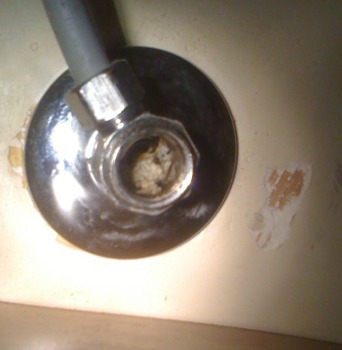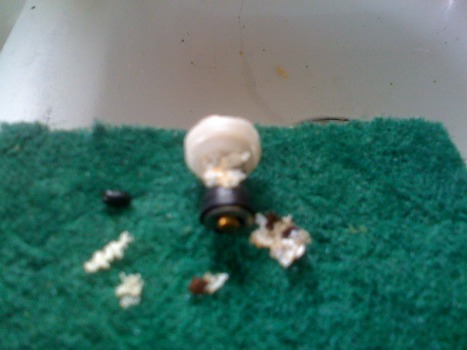Low Hot Water Pressure
A common cause of low hot water pressure [low water flow] is the accumulation of dip tube particles in the hot water pipes, faucets, valves, and shower heads.
What Is A Dip Tube
Your low hot water pressure may be caused by something called a dip tube.
Inside of your water heater hot water rises above cold water, the molecules being larger are lighter. Just as in air, hot air rises above cold air. There was a time when all cold water inlet pipes on water heaters were tapped into the bottom of the water heater tank. By doing this it was sure that the cold water entering the tank entered at the bottom of the tank where it would have the least impact on the pool of hot water floating at the top of the tank. At some point this practice ended in favor of tapping both hot water pipes and cold water pipes into the top of the tank. In order to prevent the cold water from mixing with the pool of hot water at the top of the tank, causing it to become tepid, a tube is inserted into the cold water inlet. This tube, known as a dip tube, shunts the cold water to the bottom of the tank.
Dip tubes are made of white plastic which may begin to disintegrate in hot water. Most plastics are petroleum based and oil is lighter than water. Pieces of dip tube as they break away, may float to the top of your water heater where they are apt to enter the hot water outlet of the tank. From there they begin a journey through the hot water distribution system till they either accumulate and create low hot water pressure in a branch or a fixture. Dip tube debris may pass through the hot water pipes into aerator screens or shower heads, if they are small and brittle, or lodge in valves and interfere with moving parts causing general mischief and damage. Small pieces tend to travel evenly though the system while large pieces may need to be softened by hot water to move along so they will tend to move toward fixtures where the hot water is run longer like shower valves and clothes washers.

Here is a view of a service valve, [angle stop] with the stem removed to show why it had low hot water pressure.

Here is the diverter assembly of a Delta faucet. It was supplied by the service stop pictured above. You can see some rust and a great amount of dip tube. Hot and cold water in this single handle faucet must pass through the diverter. This faucet was only passing a trickle of water, hot or cold. I cleared other faucets on this job as well and also replaced the water heater on a subsequent trip. Still until the remainder of the dip tube works its way through the hot water system they may develop low hot water pressure again.
I apologize for the phone photo but you get the idea.
Dip Tube Failure
Fragments of dip tube may look like crumbly white chalk, thin white or ivory colored flakes, or hard white flat plastic. Other than seeing this pale debris appear at a point of use you may suspect you have a dip tube problem if you run out of hot water in a certain way. The normal way to run out of hot water is when the pool of hot water floating at the top of the tank is consumed. As hot water is used cold water replaces it. The diminishing pool of hot water is replaced by an increasing pool of cold water. These two pools are divided by a band of tepid water. As the hot water is used up this band of tepid water slowly rises up toward the top of the tank. What you should experience when the tepid water reaches the tank outlet is no more hot water at the point of use. You will then have tepid water for only a minute or two, than finally only cold water.
When a dip tube is not present, or is present but has fallen away from its place, or has failed by disintegrating, the incoming cold water flows directly into the pool of hot water at the top of the tank. In this case you should experience a few minutes of hot water then tepid water that continues without beginning to flow cold.
What To Do
Replacement dip tubes are available but to do the job right the old tube must be removed from the inner tank. This can be very hard to do if the tube has disintegrated, or fallen into the tank. Three things to consider if faced with a dip tube problem are.
A- Any scraps of dip tube left in the tank may invade the hot water system where it will once again create low hot water pressure.
B- A detached dip tube that is otherwise intact may float up to the hot side outlet where it would cause the outgoing water to flow from the bottom of the tank. This in conjunction
with a new dip tube on the cold side would act like there was no dip tube at all in the tank. The saving grace here is if it only happens on occasion it is only an occasional problem, and if it really lodges in the hot port there is a good opportunity to go in and grab it out.
C- If the tank is old enough to have a bad dip tube is it probably too old to work on. This is especially the case if you are paying me one hundred dollars an hour to play with it. If you, like me, like to make the tank give you your money's worth you may want to try your luck with it. There are different types of tubes that attach in different ways. One is a simple tube with a flared flange at its top. This flared tube requires a receiving ring that you should be able to see or feel at the end of the 3/4" female inlet thread on the cold water side only. Another style of tube is attached to a replacement 3/4" inlet nipple. If you have the remnant of the old tube replace it with one of the same style. If you do not have a remnant and you think you feel the receiving ring mentioned above try to start the flanged dip tube into the tank flange first. If it will enter that way DO NOT USE IT.
The length to cut your new dip tube is simple. You want it to end just above the lower element of an electric water heater or just above the control valve center of a gas water heater.
Good luck with your low hot water pressure, let me know if I can help.
Back to Do It Yourself Plumbing Repair from Low Hot Water Pressure